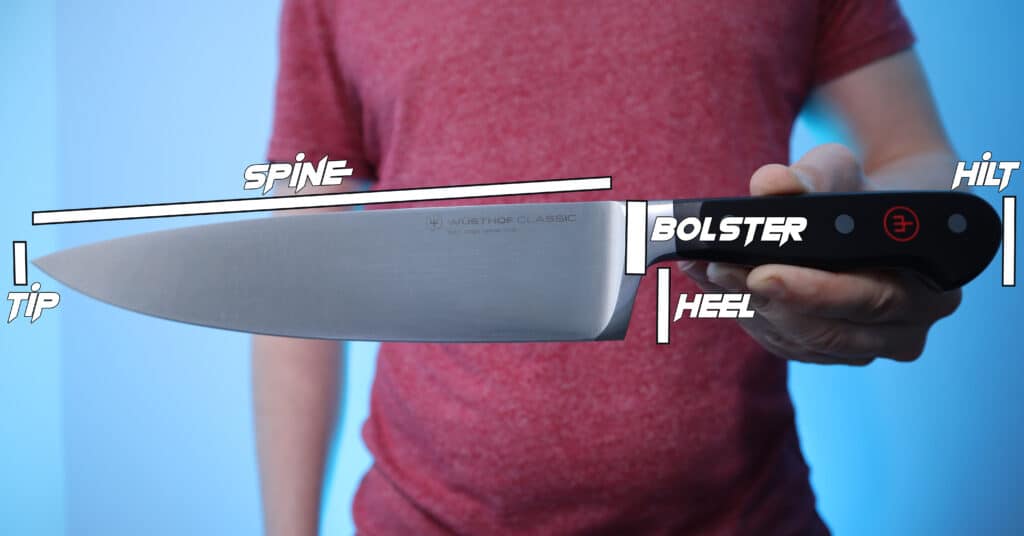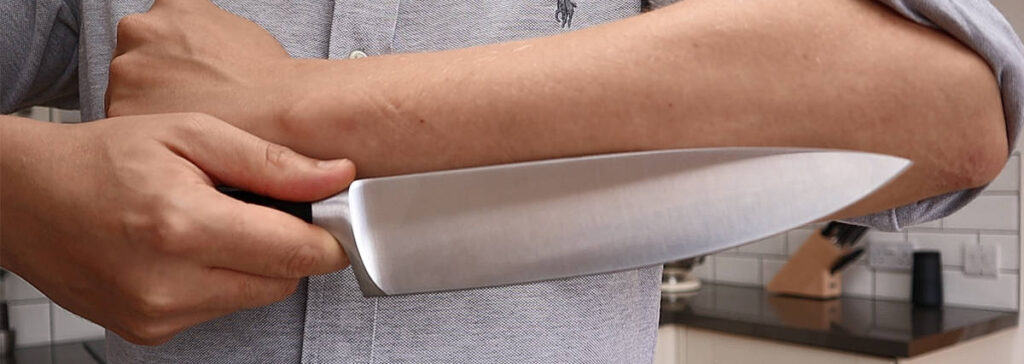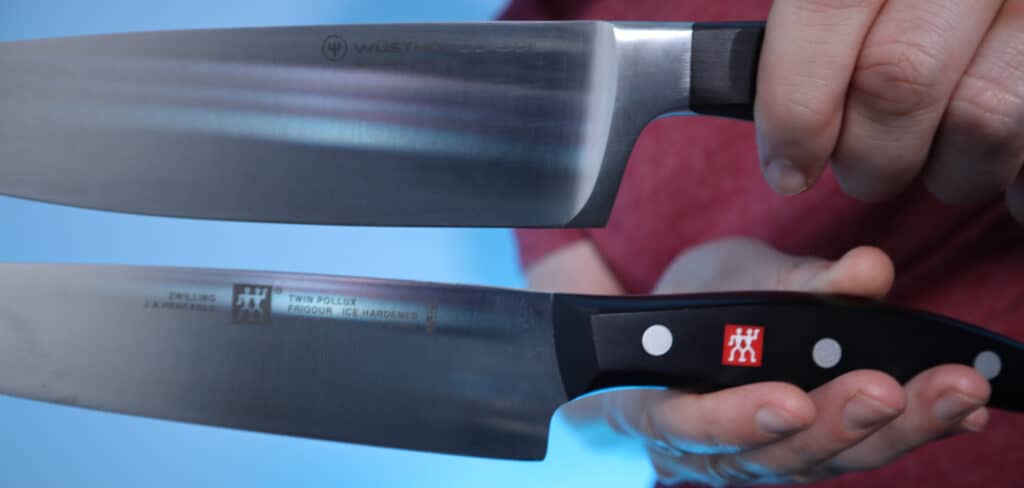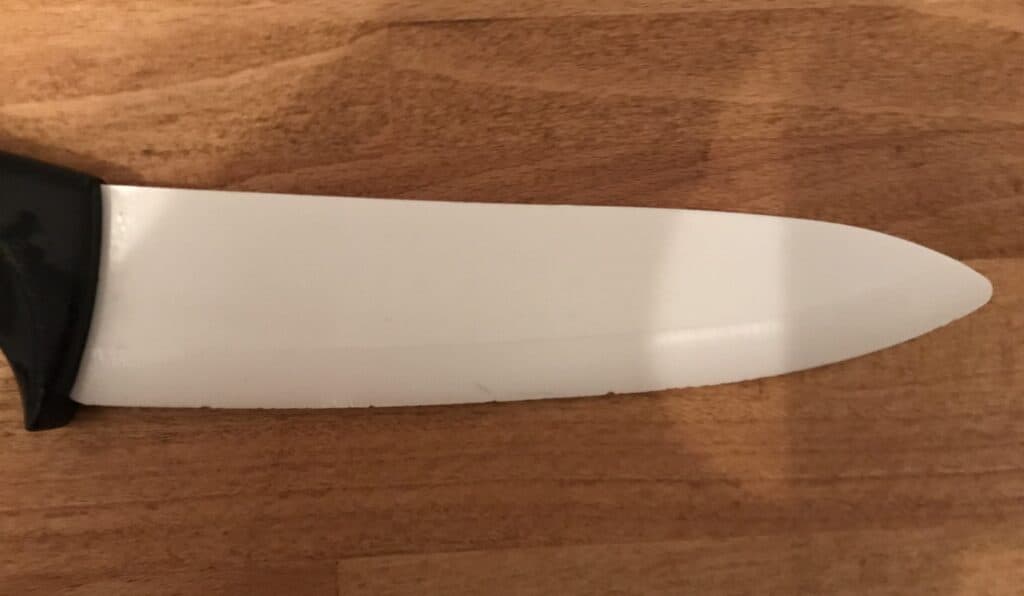
When buying a knife, you need to pay attention to the length. Different lengths of knives suit different people, and there are uniform ways in which knife lengths are measured which you need to understand.
It’s a pretty important question, especially for your main kitchen knife, or chef’s knife, where buying a knife too large or too small can make them harder to handle.
Let’s take a look at whether the knife length includes the handle, along with other knife dimensions you should be aware of.
The quick answer
- Knife length does not include the handle. The length is the tip of the blade to the bolster. Essentially the knife length should refer only to the blade length, and does not include the length of the handle.

For full details on how to measure a knife, read my guide below or watch this video.
Chef’s knives I recommend
I’ve written some useful articles featuring a range of chef’s knives that use great materials and are produced by top-class knife manufacturers. If you’re looking for a chef’s knife then I would recommend taking a look at them below.
| Knife size | My personal favorite | View the full list |
|---|---|---|
| The best 8-inch chef’s knives(average) | Wüsthof Classic 8 Inch (link to Amazon) | Take me there |
| Chef’s knives for small hands | Global 6 Inch (link to Amazon) | Take me there |
| Chef’s knives for big hands | Global 10 Inch (link to Amazon) | Take me there |
How to measure a knife
The length of a knife is measured from the bolster to the tip of the blade. Essentially the length of a knife is equal to the length of the blade only, it does not include the handle. Therefore, an 8-inch knife means that the blade itself will be 8-inches long.
The diagram below clearly shows which part of the blade is equal to the length.

When choosing which chef’s knife size is right for you, there are two easy ways to measure a suitable length. You can either base the length of the blade on the height of the user, or use the forearm test to get a more accurate best-fit of blade length.
Choosing the right knife length
Sizes of chef’s knives
Chef’s knives come in many different sizes but by far the most popular knife sizes are between 8 and 10 inches.
| Blade (Knife) Length | Size |
| 6 inches | Small |
| 8 inches | Medium |
| 10 inches | Medium-large |
| 12 inches | Large |
| 14 inches | Huge! |
How to choose chef knife size
Method 1. Chef knife size guide
Below is a table that gives some estimates for how different knife lengths may suit different people based on their height.
The most popular knives for home use are 8 – 10 inches in length. If you’re getting a knife as a gift then this table should be really useful.
If you’re purchasing it for yourself then you can also use the forearm test in the next section.
| User Height | Blade Length | My Recommendations |
|---|---|---|
| < 5.4 ft | 6 inches | Global 6 Inch (link to Amazon) |
| 5.9 ft | 8 inches | Wüsthof Classic 8 Inch (link to Amazon) |
| > 6.1 ft | 10 inches | Global 10 Inch (link to Amazon) |
For home use, it’s usually worth considering whether a knife will be shared between partners or the family. You may think you can handle a 12-inch knife, but it may not be very practical for other members of the household!
In these cases, we find it best to pick the size which is in between, usually the 10 or 8-inch knife.
Method 2. The forearm test
The above table is a very useful guide of which knife you should buy, especially if you are buying it as a gift and don’t have access to the receiver’s forearm!
But we all come in different shapes and sizes and there is a really quick and easy way to measure whether a knife is the right size for you. The forearm test.
Measure the knife from the tip of the blade to the heel of the blade against your forearm, with the heel at your wrist. Usually, you will be comfortable using a knife that is a similar length to your forearm.

You should be looking for a knife that has a similar length from heel to tip as your wrist to your elbow.
If it’s longer than your forearm then you might find it difficult to control. If it’s shorter than your forearm then you miss out on.
We all have differently proportioned limbs, so although the table we have presented is a really useful rough guide, the forearm test should ensure that you pick the perfect knife for you.
My video at the top of this article shows how to do the forearm test in detail, with or without an actual knife.
The heel of a knife
If you’re purchasing a larger knife for chopping then the length of the heel of the knife is an important consideration.
The heel of the knife is the part of the blade between the handle and the end of the blade. Essentially it’s the space your knuckles will have between the handle and the chopping board. You don’t want to keep hitting your fingers on the board whilst you chop so you should try and get a knife with the right size heel for your hand. Even if two knives have the same length the size of the heel can be very different as you can see in this picture, the top knife has a way larger heel than the bottom knife.

Whilst the size of the heel usually won’t be specified on a product description page, since the product description will show the length of the blade, you will be able to judge it quite well from the product image. Even better, if you can try a few different chef knives in person at a local store you can get an even better understanding of how big a heel is comfortable for you.
Parts of a knife

Above is an illustration of a chef’s knife, the most versatile knife in the kitchen, you may also know it as a chopping knife. Knives come in many different shapes and sizes but the basic principles of the parts of a knife can be applied to pretty much any knife type. As the chef’s knife is the most used knife in the kitchen it’s important to get the correct size for you, so we’ve made a guide later in the article about how to choose the correct sized chef’s knife.
Length
The length of a knife usually refers to the blade length, from the tip of the blade to the bolster.
However! You will see some product descriptions which measure the whole knife, from tip to hilt. You should be able to tell from the product description whether they have done this. If the whole knife has been measured then the seller should split the blade length and handle length in the description.
If only one length is stated in the description then it should refer to the length of the blade only.
Bolster
The bolster is the thick section of the blade that attaches to the handle.
Heel
The heel is the section of the blade between the bolster and the sharp edge of the blade.
The length of the heel is important because it is the space available for your knuckles. If you have large hands and you buy a knife with a small heel then there’s a good chance you’ll be knocking your knuckles on the chopping board.
Choosing a knife with an appropriate heel size is pretty important so I’ve written more about it below.
Hilt
The hilt of a knife is the end of the handle, i.e. the part of the handle furthest away from the blade.
Always read the description
As I’ve discussed, a knife length should be describing the blade length; however, it may sometimes be the case where the length shown represents the length of the knife from tip to heel.
That’s why it’s really important to check the description of the product. If they have shown the main measurement from tip to heel then they should split the blade and handle lengths in the description. If they only show one measurement then it is more than likely to be the blade length as this is the accepted standard.
For a final check, you can always refer to our size guide above to check whether the advertised length and what you see in the product picture makes sense when compared with the average knife length.

